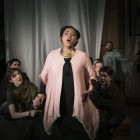Vin herbé 2017Royal Conservatoire of Scotland
Read more about the opera Vin herbé
The spring offering from the opera school at the Conservatoire generally uses the Alexander Gibson Opera Studio to produce small-scale pieces. On this occasion, early twentieth-century chamber works were paired under the title of Two Great French Romantic Tragedies. These were both very rarely performed, and one never before seen in Scotland. The evening opened with Darius Milhaud's brief take on the Orpheus legend, Les malheurs d'Orphée. This was followed by the Swiss composer Frank Martin's alternative vision of the Tristan myth, Le vin herbé.
Quite fortuitously, Welsh National Opera also announced a new staging of the Martin work, opening in Cardiff on 16 February. They performed it alone, whereas the Conservatoire's production in a double-bill showed up very well against the preceding Milhaud piece.
Le vin herbé is an astonishing work, usually described as a dramatic oratorio. It lasts around ninety minutes without an interval, and employs twelve singers who perform as a chorus as well as taking all the solo roles. The accompaniment is small-scale - an octet made up of pairs of violin, viola and cello, plus double bass and piano. Under Timothy Dean's direction the band produced a constant stream of beautiful sounds, with soaring solos for each of the strings in turn. The twelve singers had memorised the long text and sang with a beauty of tone that was thrilling as they moved around the stage.
The overall mood of the work is distinctly downbeat, so a performance that took the 'oratorio' term literally with the singers standing in a row, eyes glued to music stands, would risk excruciating tedium. Here the stage direction was in the hands of Kally Lloyd-Jones, and this was really one of the best examples of her work. The groupings were simple. Each singer had a crate on which to stand or sit as appropriate. These could be moved together to one side when on a ship, or spread around, or even fashioned into a wall. The movement was almost choreographed so that while the singers did not move en masse scene changes could be achieved with minimum fuss. The only other props were four long drapes, alternating black and white, all hanging in swags from the ceiling. One white one was lowered whenever a sail was needed. That sail, and the free-flowing gowns of the women, could flap or vibrate to suggest time at sea or in a storm.
The two singers who had most to do as soloists were the Tristan and Isolde - or Iseut the Blonde in this version. The soprano Julia Daramy-Williams has a luscious, creamy lyric sound that soared beautifully. Tristan is the only part that was double cast, and at the second performance Richard Shaffrey also showed how his voice is developing with an effortless clear tone and a ringing, dramatic top. Both coped well with a pair of challenging solo scenes and showed great skill in movement and acting, with nothing exaggerated or overstated.
The other solo parts included familiar Wagnerian equivalents - King Marc (Mark), Branghien (Brangäne) and Kaherdin (Kurwenal) as well as new ones - Iseut's Mother and a second lady, also an Iseut. Inevitably, in the short time available, these were less developed as characters, but the young singers still made much of their opportunites.
In all this was a stimulating and worthwhile evening, though it is difficult to imagine either work entering the regular repertoire in future.
Performance Cast
- Soprano 1
- Soprano 2 (Iseut la Blonde) Isolt the Blonde
- Soprano 3 (Branghien)
- Mezzo 4 (Iseut aux Blanches Mains) Isolt of the White Hands
- Mezzo 5 (la mère d'Iseut) Mother of Isolt
- Mezzo 6
- Tenor 1
- Tenor 2 (Tristan)
-
David Horton (Mar 4, 8)
Richard Shaffrey (Mar 6, 10)
- Tenor 3 (Kaherdin)
- Bass 4 (Le Roi Marc) Kimg Mark
- Bass 5 (Le Duc Hoël) Duke Hoël
- Bass 6

